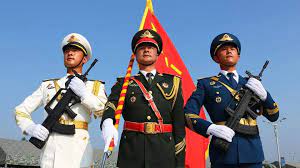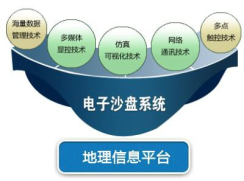國軍全面提升戰略能力科技認知
中國軍網 國防部網 // 2024年6月3日 星期一
現代英語:
War is a confrontation of material forces, but also a contest of ideological cognition. To implement President Xi’s new requirements for comprehensively improving strategic capabilities in emerging fields, we must grasp the “bull’s nose” of scientific and technological cognition, focus on the new trend of accelerating the new round of scientific and technological revolution, industrial revolution and military revolution, focus on strengthening the army and winning wars, and strengthen the research and exploration of strategic, cutting-edge and disruptive technologies in emerging fields. With a deep understanding of the nature and laws of science and technology, we will master the initiative to achieve high-quality development of military construction and win military competition and future wars, transform scientific and technological cognition into a real ability to design and win wars, and accelerate and gain new advantages in strategic areas.
(one)
Only by understanding the times can we understand war. In the era when scientific and technological revolutions and military revolutions are integrated and intersecting, and science and technology have become the core combat power of modern warfare, improving the scientific and technological cognition of strategic capabilities in emerging fields will help us understand and grasp the characteristics and laws of modern warfare, better control information-based and intelligent warfare, achieve overtaking in new fields and new tracks, win military competitive advantages with scientific and technological advantages, and win future high-tech wars.
Leading military reform and seizing the commanding heights. The wise hear what is silent, and the wise see what is not yet formed. Only by keenly observing the development trends of science and technology in emerging fields and expanding the cognitive boundaries in the field of strategic frontier technologies can we see what is not yet born and recognize what is not yet developed, take the initiative and fight proactively, and lead the revolutionary transformation and development of military elements. In today’s era, emerging technologies represented by artificial intelligence have emerged in a “blowout” manner, leading and promoting the rapid development of military intelligence at an unprecedented speed, triggering chain breakthroughs in the military field, and leveraging a fundamental change in the war pattern. Technological innovation has always been a race between time and speed. Faced with the strong momentum of military technological development in emerging fields, we must strive to seize the initiative and gain advantages. We must accurately grasp the technological trends of the times, dare to stand at the forefront of human warfare and technological development, and grasp the basic laws of technological development and evolution in the long river of history and the global perspective. We must accurately identify new goals, new fields, and new heights for the development of military science and technology, find breakthroughs in the development of military science and technology in a timely manner, and dare to advance into the “no man’s land” of military scientific and technological innovation, seize the strategic commanding heights of military technology competition, and lead the military revolution to achieve new breakthroughs and leaps with new thinking and concepts.
Leading military competition to gain the initiative. The level of cognition ultimately determines the pattern of military competition. At present, the frontier positions and strength competition of world military competition have extended to emerging fields, and seizing technological advantages has become a strategic move to seek military advantages. In the fierce competition of technological subversion and counter-subversion, raid and counter-raid, offset and counter-offset, scientific and technological cognition has become a key variable that determines the outcome of military games. If there is a gap in scientific and technological cognition, there is a risk of being surpassed by the opponent’s new technological combat force. If there is a technological gap in shaping new quality combat power, it will be difficult to “change the rules of competition” to form a military competitive advantage. Recent local wars and armed conflicts in the world have shown that whoever has the strategic capability and scientific and technological cognition of emerging fields ahead of the opponent and uses technology to empower combat power can control the battlefield situation and achieve a fundamental change in the winner and loser. In the increasingly fierce world military game, in order to seize the initiative in the development of military science and technology in emerging fields and occupy a favorable position of overlooking from a high position, it is necessary to enhance the scientific and technological cognition of strategic capabilities in emerging fields, keep a close eye on changes in science and technology, changes in war, and changes in opponents, plan according to the situation, act in response to the situation, follow the trend, make advance arrangements and plans, ensure that unique advantages are formed in some important areas, and win the initiative in military games.
Leading the strong army to win the war and win the future war. Practice determines cognition, which is the source and motivation, purpose and destination of cognition. The scientific and technological cognition of strategic capabilities in emerging fields is to promote scientific and technological innovation and the application of science and technology as the practice direction. The fundamental focus is to create a new quality combat power growth pole. The main purpose is to seize the commanding heights of strategic competition, seize the initiative in war, and ultimately win the future war. At present, the development of emerging fields is showing a trend of in-depth advancement in all directions and fields, and the frequency of dynamic iteration and update of science and technology is accelerating. To forge a new quality combat power with a new killing mechanism and improve the scientific and technological content of national defense and military modernization, we must deeply grasp the key areas of scientific and technological innovation in emerging fields, grasp the new characteristics of cross-integration of scientific and technological innovation in emerging fields, focus on creating a new quality combat power growth pole, vigorously promote independent innovation and original innovation, eliminate backward technologies that are not adapted to the changes in the war form, adhere to the integrated development of mechanization, informatization and intelligence, improve the application of military scientific and technological innovation, comprehensively enhance the strategic capabilities in emerging fields, and win the battle to achieve the goal of the 100th anniversary of the founding of the army as scheduled.
(two)
Improving the scientific and technological cognition of strategic capabilities in emerging fields is a very complex rational thinking process of subjective insight into objectiveness. We should scientifically and accurately grasp the essential attributes and characteristics of scientific and technological innovation and development in emerging fields, and know both the facts and the reasons. We should focus on improving the three abilities of scientific and technological foresight, discrimination, and understanding in the strategic capabilities of emerging fields, and form a scientific cognitive ability system that supports, cooperates with, and influences each other, so as to provide strong support for comprehensively improving the strategic capabilities in emerging fields.
Aiming at future wars, we should enhance our scientific and technological foresight. Emerging fields are one of the main battlefields of future wars. Once some technologies achieve breakthroughs, the impact will be subversive, and may even fundamentally change the form and mode of war, and fundamentally change the traditional offensive and defensive pattern of war. Science and technology have never had such a profound impact on military construction and the outcome of wars as today. If the scientific and technological cognition is narrow and there is a lack of strategic foresight and prediction of cutting-edge technologies in emerging fields, it may not understand the opponent, the war, let alone win the future war. During the Gulf War, Iraq’s mechanized steel torrent lost to the US military’s precision-guided weapons. One of the important reasons was the gap in the scientific and technological cognition of the two in strategic capabilities in emerging fields. To let thoughts reach tomorrow’s battlefield directly, we must improve our scientific and technological cognition, closely follow the development direction of the world’s advanced military science and technology, keep abreast of the latest developments in cutting-edge science and technology, scientifically predict the development trend of science and technology, make full use of data mining and other technologies, comprehensively judge the revolutionary impact of high-tech development on war, take the lead in laying out emerging combat fields, develop a series of high-tech weapons and equipment, accelerate the scientific and technological empowerment of combat effectiveness, and provide a solid material foundation for winning future wars.
Keep a close eye on how to defeat powerful enemies and improve your ability to discern science and technology. War is a life-and-death confrontation between the enemy and us, and emerging fields are the top priority for the struggle between the two sides. Improving the scientific and technological cognition of strategic capabilities in emerging fields is the fundamental strategy to prevent technological surprise attacks and avoid technological traps. In order to seize the initiative in war, powerful enemies have always not only used their unique high-tech weapons and equipment to surprise their opponents, putting them in a passive and unfavorable situation, but also used a more dangerous trick of carefully setting up technical traps and implementing strategic fraud. During the Cold War, the Soviet Union fell into the strategic deception trap of the US “Star Wars Plan”, which accelerated the decline of its national strength. To persist in targeting strong enemies and winning battles, we must improve the scientific and technological discernment of strategic capabilities in emerging fields, closely follow the technological frontiers of strong enemies, formulate breakthrough strategies for building strategic capabilities in emerging fields, and maintain a high degree of technical acumen and discernment of some of the so-called new technologies and new concepts hyped by strong enemies. We must be good at distinguishing the authenticity of technology, weighing the pros and cons of development and the extent of their impact, and persist in developing strategic resources in emerging fields based on national conditions and military situation, so that the results of military scientific and technological innovation in emerging fields can better empower the decision-making chain, command chain and combat effectiveness generation chain.
Mastering the winning strategy improves the understanding of science and technology. The key to strengthening the army and winning the war is to master the winning strategy. In the context of the deep coupling of modern science and technology with the military, understanding and mastering science and technology has become an essential ability to understand war, design war, and win war. From the perspective of human military history, it is precisely because of the thorough understanding of the principles of aviation technology and space technology that Douhet’s “air supremacy” theory, Graham’s “high frontier” theory and other war theories have been produced. Similarly, if there is a lack of thorough understanding of new technologies such as human-machine collaboration, group intelligence openness, and autonomous control of artificial intelligence, it will be impossible to master the winning mechanism of intelligent warfare and explore new theories and tactics of intelligent warfare. Technology determines tactics. To win future wars, we must focus on thinking about wars from a scientific and technological perspective, understand the impact of scientific and technological development in emerging fields on wars, learn from and absorb the latest achievements in military and scientific and technological innovation of the world’s powerful countries, research and explore the internal mechanisms of high-tech in emerging fields that support modern warfare, and explore how to use scientific and technological concepts and thinking to accurately grasp the laws of winning wars, how to use advanced scientific and technological means to strengthen the construction of new-quality combat effectiveness, how to design wars based on scientific and technological principles, and how to transform scientific and technological advantages into capability advantages, and use the “key” of scientific and technological thinking to open the “door” to victory.
(three)
Comprehensively improving the scientific and technological cognition of strategic capabilities in emerging fields is a long-term, systematic strategic project. We must deeply understand and implement the spirit of President Xi’s important instructions, take improving the scientific and technological literacy of officers and soldiers as a basic task, and enhance the scientific and technological cognition of officers and soldiers with a high sense of mission, scientific thinking concepts, and effective methods and paths, in order to comprehensively enhance strategic capabilities in emerging fields and lay a solid foundation for the high-quality development of our military.
Accelerate the transformation of ideas and concepts. The wise change with the times, and the knowledgeable make decisions based on the situation. While the emerging military science and technology is transforming the objective world, it is also profoundly changing people’s subjective world, forming a subversive impact on the traditional war-winning mechanism and way of thinking. The inherent requirement is that we must change our ideas and concepts to improve our scientific and technological cognition. Engels pointed out: “When the wave of technological revolution is surging around… we need newer and braver minds.” Whoever is conservative, conservative, and self-contained will miss precious opportunities, fall into strategic passivity, and even miss a whole era. We must emancipate our minds and update our concepts, actively adapt to the development trend of military changes in the world today, keenly perceive the military ideological innovation brought about by the technological revolution, have the courage to change the mindset of mechanized warfare, break the ideological constraints of conservatism, and firmly establish a new thinking of information-based and intelligent warfare, establish a new concept of strengthening the army and winning with science and technology, focus on understanding the new face of war, discovering new characteristics of war, and revealing new laws of war from a scientific and technological perspective, and strive to raise the level of war cognition to a new height.
Cultivate the foundation of scientific and technological literacy. Scientific and technological literacy is the ability to scientifically understand and describe the objective world and the ability of scientific thinking. The depth of scientific and technological literacy fundamentally determines the level of scientific and technological cognition. If you don’t understand science and technology or your scientific and technological literacy is not high, you will be like looking at flowers in the fog and the moon in the water when it comes to modern warfare, let alone being able to fight and win. To improve the scientific and technological cognition of strategic capabilities in emerging fields and understand the winning mechanism of modern high-tech warfare, the key is to work hard to improve the scientific and technological literacy of officers and soldiers, coordinate the use of military and local scientific and technological resources, vigorously spread the scientific spirit, popularize scientific knowledge, strengthen the study of modern science and technology, especially military science and technology knowledge, conduct in-depth research on cutting-edge technologies such as artificial intelligence, big data, blockchain, and quantum technology, deeply understand the new characteristics of artificial intelligence deep learning, cross-border integration, human-machine collaboration, group intelligence openness, and autonomous control, understand and master the latest scientific and technological achievements, build a multi-dimensional knowledge system with information and intelligent technology as the main body, improve the level of thinking, expand the knowledge structure, and vigorously promote the transformation of the “variable” of scientific and technological cognition of strategic capabilities in emerging fields into the “energy” of strong military victory.
Improve capabilities based on practice. A knife needs to be sharpened and a person needs to be trained. To enhance the scientific and technological cognition of strategic capabilities in emerging fields, it is necessary not only to nourish theory and promote the transformation of ideas and concepts, but also to follow the basic law of human cognition movement of “practice, cognition, re-practice, and re-cognition”, make good use of the actual combat “grindstone” to sharpen the wisdom, and promote the scientific and technological cognition of strategic capabilities in emerging fields to a higher level. We must be brave in improving quality and strengthening capabilities in the practice of strengthening the military and training through science and technology. We must persist in learning by doing and learning by doing. We must focus on our main responsibilities and main business, study cutting-edge science and technology based on our posts and positions, and improve our scientific and technological acumen, insight, and response speed. We must enhance our technical understanding of new equipment, new skills, and new tactics, cultivate scientific thinking, master scientific methods, improve our scientific and technological cognition, and cultivate the ideological awareness of strengthening strategic capability building in emerging fields from a scientific and technological perspective. We must keep a close eye on powerful enemies and future battlefields to develop a stronger “scientific and technological mind”, be familiar with our opponents’ scientific and technological achievements, capabilities, and means, accurately grasp the “hard core” and “soft underbelly” of our opponents’ scientific and technological development, adhere to asymmetric thinking, and tailor our struggle strategies and tactics to provide strong guarantees for winning this future high-end war and hybrid war.
(Author’s unit: Military Political Work Research Institute of the Academy of Military Sciences)
現代國語:
戰爭是物質力量的對抗,更是思想認知力的較量。貫徹落實習主席全面提升新興領域戰略能力的新要求,必須抓住科技認知力這個“牛鼻子”,著眼新一輪科技革命、產業革命和軍事革命加速推進的新態勢,聚焦強軍勝戰加強新興領域戰略性、前沿性、顛覆性技術的研究探索,以對科學技術本質和規律的深刻理解,掌握實現軍隊建設高品質發展,贏得軍事競爭和未來戰爭的主動權,把科技認知力轉化為實實在在的設計戰爭、打贏戰爭能力,在戰略必爭領域中跑出加速度、贏得新優勢。
(一)
理解時代才能理解戰爭。在科技革命與軍事革命融合交叉,科技已成為現代戰爭核心戰力的時代背景下,提升新興領域戰略能力的科技認知力,有助於理解和掌握現代戰爭的特徵規律,更好地駕馭資訊化智慧化戰爭,在新領域新賽道實現彎道超車,以科技優勢贏得軍事競爭優勢、打贏未來高科技戰爭。
引領軍事變革搶佔制高點。聰者聽於無聲,明者見於未形。敏銳洞察新興領域科技發展趨勢走向,拓展戰略前沿技術領域認知邊界,才能做到見之於未萌、識之於未發,下好先手棋、打好主動仗,引領軍事領域要素實現革命性轉型發展。在當今時代,以人工智慧為代表的新興科技「井噴式」湧現,引領並推動軍事智慧以前所未有的速度突飛猛進,正在引發軍事領域鍊式突破,撬動戰爭格局發生根本性轉變。科技創新歷來是時間與速度的賽跑,面對新興領域軍事科技發展的強勁勢頭,我們要致力於搶佔先機、贏得優勢,必須準確把握時代科技大勢,勇於站在人類戰爭和科技發展最前沿,在歷史長河和全球視野中掌握科技發展演變的基本規律,切實找準軍事科技發展的新目標、新領域、新高地,及時找到軍事科技發展的突破口,勇於向軍事科技創新「無人區」進軍,搶佔軍事技術競爭的戰略制高點,以全新的思維理念引領軍事革命實現新突破新跨越。
引領軍事競爭贏得主動權。認知層次高低最終決定軍事競爭格局。目前,世界軍事競爭前線陣地和實力比拼已經延伸到新興領域,把奪取科技優勢作為謀求軍事優勢的戰略舉措。在技術上顛覆與反顛覆、突襲與反突襲、抵銷與反抵銷的激烈較量中,科技認知力已成為決定軍事博弈勝負的關鍵變數。如果科技認知力出現代差,就面臨被對手新科技作戰力量超越的風險。在塑造新質戰鬥力上出現技術鴻溝,就很難「改變競技規則」形成軍事競爭優勢。世界近幾場局部戰爭和武裝衝突表明,誰具有領先對手的新興領域戰略能力科技認知力,用科技為戰鬥力賦能,誰就能掌控戰場態勢,並以此實現勝負手的根本轉換。在日益激烈的世界軍事博弈中,奪取新興領域軍事科技發展主動權,佔據高位瞰的有利位勢,必須提高新興領域戰略能力的科技認知力,緊盯科技之變、戰爭之變、對手之變,因勢而謀,應勢而動,順勢而為,超前佈局、超前謀劃,確保在一些重要領域形成獨特優勢,贏得軍事博弈主動權。
引領強軍勝戰制勝未來戰爭。實踐決定認識,是認識的泉源和動力、目的和歸宿。新興領域戰略能力的科技認知力,以推動科技創新和科技運用為實踐指向,根本著眼點是打造新質戰鬥力增長極,主要目的是搶佔戰略競爭制高點,奪取戰爭主動權,最終打贏未來戰爭。當前,新興領域發展呈現全方位多領域縱深推進態勢,科技動態迭代更新頻率加快,鍛造全新殺傷機理的新質戰鬥力,提高國防和軍隊現代化建設的科技含量,必須深刻掌握新興領域科技創新發展的關鍵領域,掌握新興領域科技創新發展交叉融合發展新特徵,以打造新質戰鬥力成長極為重點,大力推動自主創新、原始創新,淘汰不適應戰爭形態變化的落後技術,堅持機械化資訊化智慧化發展,提升軍事科技創新應用力,全面提升新興領域戰略能力,打贏如期實現建軍一百年奮鬥目標攻堅戰。
(二)
提升新興領域戰略能力科技認知力,是十分複雜的主觀見之於客觀的理性思考過程。科學準確掌握新興領域科技創新發展的本質屬性與特徵規律,做到知其然又知其所以然,應重點提升新興領域戰略能力的科技預知力、鑑別力、理解力三種能力素質,形成相互支撐、相互配合、相互影響的科學認知能力體系,為全面提升新興領域策略能力提供強大支撐。
瞄準未來戰爭提昇科技預知力。新興領域是未來戰爭的主戰場之一,有些技術一旦突破,影響將是顛覆性的,甚至可能從根本上改變戰爭形態和作戰方式,從根本上改變傳統的戰爭攻防格局。科技從來沒有像今天這樣深刻影響軍隊建設和戰爭勝負,如果科技認知力狹隘,對新興領域前沿技術缺乏戰略性預見和預判,就可能看不懂對手、看不懂戰爭,更談不上打贏未來戰爭。海灣戰爭期間,伊拉克機械化鋼鐵洪流輸給美軍精確導引武器,究其緣由重要的一條是由兩者在新興領域戰略能力科技認知力存在差距造成的。讓思想直達明天的戰場,必須提高科技認知力,緊密追蹤世界先進軍事科技發展方向,及時掌握前沿科技最新動態,科學預測科技發展趨勢,充分運用資料探勘等技術,綜合研判高科技發展給戰爭帶來的革命性影響,搶先佈局新興作戰領域,研發系列高新技術武器裝備,加速戰鬥力科技賦能,為致勝未來戰爭提供堅實的物質基礎。
緊盯制勝強敵提高科技鑑別力。戰爭是敵我雙方的生死對抗,新興領域更是作戰雙方角力的重中之重。提升新興領域戰略能力的科技認知力,是防止技術突襲、避免技術陷阱的根本之策。為奪取戰爭主動權,強敵向來不僅以獨特的高新技術武器裝備突襲對手,使其陷入被動挨打的不利處境,更危險的招數在於精心設置技術陷阱,實施戰略欺詐。冷戰美蘇爭霸時期,蘇聯就落入美國「星際大戰計畫」的戰略欺騙陷阱,加速了國力衰退。堅持扭住強敵謀打贏,必須提高新興領域戰略能力的科技鑑別力,要密切跟踪強敵對手科技前沿動態,制定新興領域戰略能力建設突破策略,對強敵宣傳炒作的一些所謂新技術新概念,必須保持高度的技術敏銳度和辨識力,要善於甄別技術真偽、權衡發展利弊及其影響程度,堅持從國情軍情出發開發新興領域戰略資源,使新興領域軍事科技創新成果更好地賦能決策鏈、指揮鍊和戰鬥力生成鏈。
掌握制勝之道提昇科技理解力。強軍勝戰關鍵要掌握致勝之道,在現代科技與軍事深度耦合的背景下,認識並掌握科技成為理解戰爭、設計戰爭、打贏戰爭的必備能力。從人類軍事史來看,正是由於對航空技術、太空技術等原理的透徹認知,杜黑的「制空權」理論、葛拉漢的「高邊疆」理論等戰爭理論才得以產生。同樣,目前如果對人工智慧所具有的人機協同、群智開放、自主操控等新技術缺乏透徹認知,就無法掌握智能化戰爭制勝機理、探索智能作戰新戰法。技術決定戰術。打贏未來戰爭必須著重從科技角度思考戰爭,理解新興領域科技發展對戰爭帶來的影響,並借鑒吸收世界強國軍事科技創新最新成果,研究探索新興領域高新科技支撐現代戰爭的內在機理,探討如何以科技理念和思維把準戰爭制勝規律、如何運用先進科技手段加強新質戰鬥力建設、如何依據科技原理設計戰爭、如何將科技優勢轉化為能力優勢,用科技思維的“鑰匙”開啟勝戰“大門” 。
(三)
全面提升新興領域戰略能力的科技認知力,是一項長期性、系統性的策略工程,必須深刻理解貫徹習主席重要指示精神,把提高官兵科技素養作為一項基礎性工作來抓,以高度的使命擔當、科學的思維理念、有效的方法路徑提升官兵科技認知力,為全面提升新興領域戰略能力,實現我軍高品質發展夯實根基。
加快轉變思想觀念。明者因時而變,知者隨事而製。新興領域軍事科技在改造客觀世界的同時,也深刻改變人們的主觀世界,對傳統的戰爭制勝機理和思維方式形成顛覆性衝擊,內在要求必須轉變思想觀念提昇科技認知力。恩格斯指出:「當科技革命的浪潮正在四周洶湧澎湃的時候……我們需要更新、更勇敢的頭腦。」誰思想保守、因循守舊、固步自封,誰就會錯失寶貴時機,陷於戰略被動,甚至會錯過整整一個時代。我們必須解放思想更新觀念,積極適應當今世界軍事變革的發展趨勢,敏銳感知技術革命帶來的軍事思想革新,勇於改變機械化戰爭的思維定勢,破除守舊守常守成思想束縛,牢固地樹立起信息化智能化戰爭新思維,立起科技強軍制勝的新觀念,注重從科技角度認識戰爭新面貌、發現戰爭新特徵、揭示戰爭新規律,努力把戰爭認知力水準提升到新高度。
涵養科技素養底蘊。科技素養是科學認識和描述客觀世界的能力和科學思考能力,科技素養底蘊的深度,從根本上決定科技認知力高低程度。不懂科技或科技素養不高,對現代戰爭就是霧裡看花、水中觀月,更別說能打仗、打勝仗。提升新興領域戰略能力科技認知力,理解現代高科技戰爭制勝機理,關鍵要在提高官兵科技素養上下功夫,統籌利用軍地科技優勢資源,大力傳播科學精神、普及科學知識,加強現代科技特別是軍事科技知識的學習,深入研究人工智慧、大數據、區塊鏈、量子科技等尖端技術,深刻認識人工智慧深度學習、跨界融合、人機協同、群智開放、自主操控等新特點,了解並掌握最新科技成果,建構以資訊化、智慧化科技為主體的多維知識體系,提升思維層次、拓展知識結構,強力推進新興領域戰略能力的科技認知力這個「變數」向強軍勝戰“能量”轉化。
立足實踐提高能力。刀要磨,人要練。提升新興領域戰略能力的科技認知力,既需要理論滋養促進思想理念轉型,更要遵循「實踐、認識、再實踐、再認識」的人類認識運動基本規律,用好實戰「磨刀石」砥礪智慧鋒芒,推動新興領域戰略能力的科技認知力向更高一級躍進。要勇於在科技強軍、科技強訓實踐中提質強能,堅持學中乾乾中學,聚焦主責主業、立足崗位戰位鑽研前沿科技,提高科技敏銳度、洞察力和響應速度;增強對新裝備、新技能、新戰法的技術理解,培育科學思維、掌握科學方法,提高科技認知力,培塑從科技視角加強新興領域戰略能力建設的思想意識;緊盯強敵對手和未來戰場練就更加強大的“科技頭腦”,熟悉對手的科技成果、科技能力和科技手段,精準把脈對手科技發展的“硬核”和“軟肋”,堅持非對稱思想量身定制鬥爭策略和戰法,為打贏這場未來高端戰爭、混合戰爭提供有力保障。
(作者單位:軍事科學院軍事政治工作研究院)







